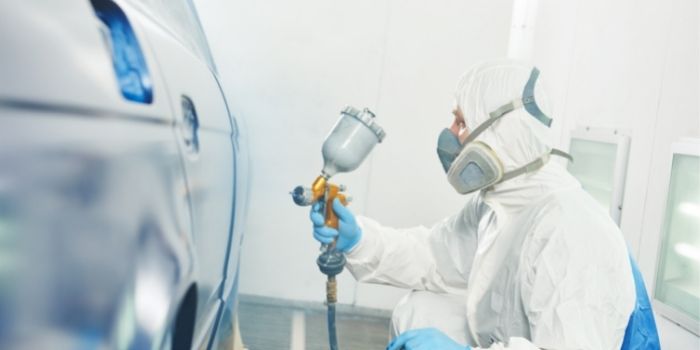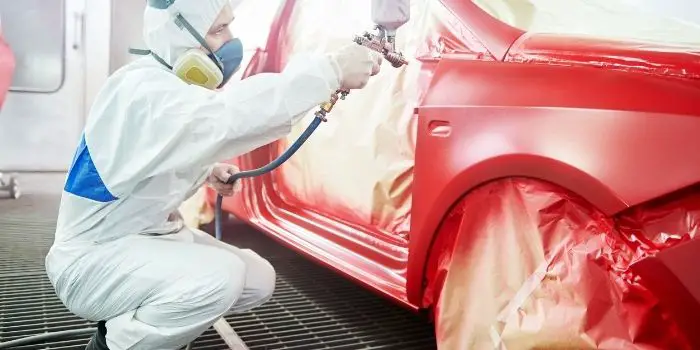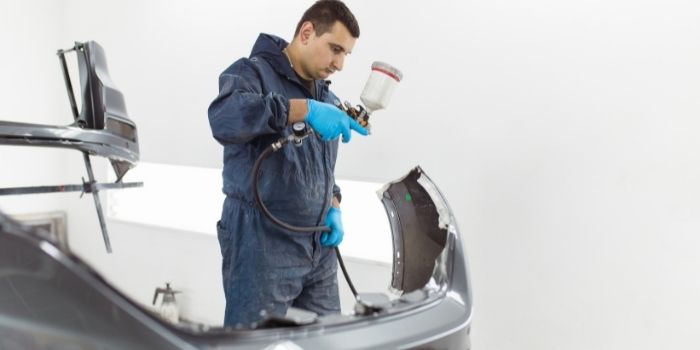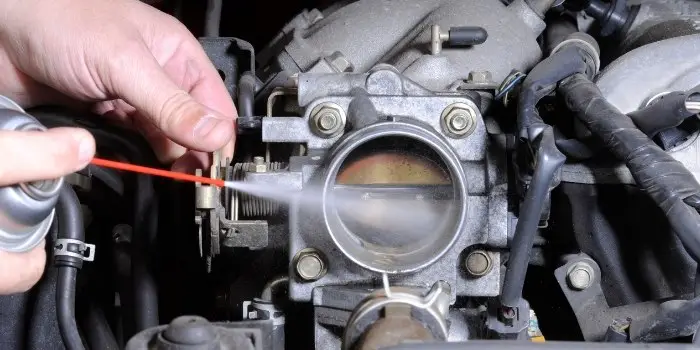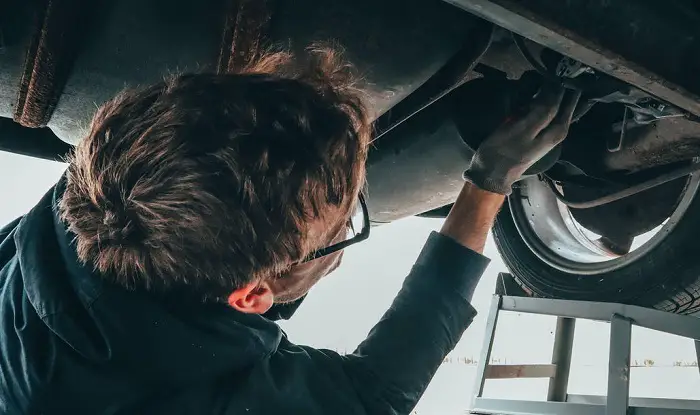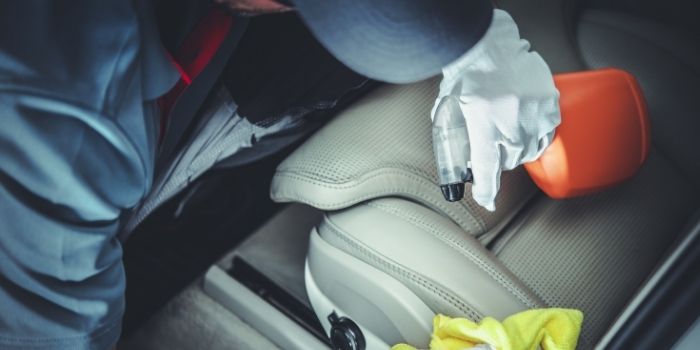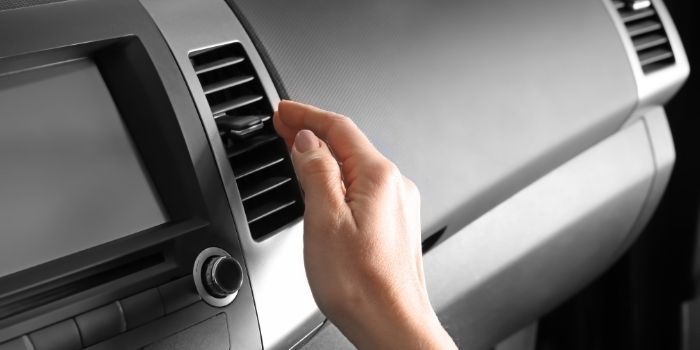Ever tried painting a car without primer?
That’s like putting icing on a cake that hasn’t been baked yet—it looks good for five minutes and then collapses into a mess.
Whether you’re fixing a few scratches or prepping a full body repaint, primer is the secret ingredient that makes everything stick, shine, and last.
But here’s the catch—not all primers are created equal. Each one has its own personality, purpose, and perfect match for your project.
Let’s break down the five types of auto body primers so you can pick the one that actually loves your car back.
Different Types of Automotive Primers
The first step in achieving a long-lasting, durable vehicle finish is selecting the proper primer for the basis of your paint job.
You might think “a primer is a primer,” but that’s like saying all coffee tastes the same (and we both know that’s a lie).
Each type of automotive primer serves a different purpose, from rust-busting warriors to silky-smooth surface finishers.
Here’s a quick tour of the five main types you’ll run into in the body shop jungle:
1. Epoxy Primer
Epoxy primer is a two-part system (resin + hardener) that chemically bonds to bare metal, fiberglass, or even old paint.
Once cured, it creates an airtight, waterproof seal that prevents rust and corrosion. It also offers excellent adhesion for subsequent coats — filler, sealer, or paint.
However, it’s not meant to be sanded directly; most pros use it as a foundation layer beneath other primers. Ideal for restoration work, bare steel panels, and humid climates.
2. Urethane Primer
This one’s a two-component primer-surfacer known for durability, flexibility, and ease of sanding.
It builds a smooth, uniform surface while resisting shrinkage over time — a common problem with cheaper primers.
Urethane primers also have UV resistance, making them stable under sunlight if you delay your topcoat.
It’s often the go-to choice before base and clear coats because it’s compatible with most modern paint systems (including urethane and acrylics).
3. Etching Primer
Etching primer contains an acid (usually phosphoric acid) that lightly “bites” into bare metal, creating microscopic anchors for better paint adhesion.
It’s a single-component primer that dries quickly and is perfect for small repairs or spot jobs where you need direct-to-metal contact.
However, never apply filler or epoxy primer over it — the acid can interfere with adhesion. Think of it as a handshake between metal and your first paint layer, not a permanent bodyguard.
4. High-Build Primer
This one’s your go-to when you want to erase the sins of sanding, minor waves, or small imperfections.
Made with high solids content, it can be sprayed on thick, then block-sanded smooth for that showroom finish.
It’s compatible with most substrates — from fiberglass to old paint — and often used after filler or epoxy primer.
Because of its viscosity, you’ll need a larger spray gun nozzle (around 1.8–2.0mm). When sanded correctly, it provides a glass-smooth surface that’s ready for color.
5. Polyester Auto Primer
This is essentially sprayable body filler, with a thick, high-build consistency that levels even deep scratches and uneven surfaces.
It cures by peroxide hardener (like traditional body filler), not by air-drying, which makes it extremely stable with minimal shrinkage.
Polyester primer sands like butter and is great when you’re doing full restorations or repairing damaged panels.
However, it must be sealed with an epoxy or urethane primer before painting, as it’s porous and can absorb moisture if left exposed.
Why Auto Primer Matters Before Paint?
In the world of car painting, primer isn’t just an optional extra — it’s the secret that makes your paint job last.
Applied to freshly sanded or bare metal before the topcoat, primer acts like a grip layer, helping paint stick properly and stay smooth for years.
It can be brushed or sprayed, depending on the job, but its purpose stays the same — protection and adhesion.
Skipping primer might seem tempting, but it’s a shortcut that never pays off.
Bare metal doesn’t bond well with paint on its own, which leads to peeling, flaking, and eventually rust — the kind that slowly eats your car from the inside out.
Primer sealer fixes that by creating a tight bond between the surface and the paint, locking out air and moisture that cause corrosion.
In short, primer sealer is like your car’s invisible shield — it helps the paint stick better, look smoother, and last longer, while protecting the metal underneath from rust and damage.
What Type of Primer to Choose for Your Old Car?
The auto body primer isn’t just the first coat—it’s the foundation that bonds your paint, seals out moisture, and keeps rust from creeping back.
So, when you plan for restoring or repainting an older car, choosing the right primer can make all the difference between a finish that lasts decades and one that peels within months.
Here’s a brief guide on what you should choose, depending on the extent of your repair or repainting work on your old classic car.
For large-scale restoration or full-body repainting, epoxy primer is often the top pick.
As a two-component formula, it offers outstanding adhesion to bare metal, fiberglass, fillers, and even old factory finishes.
It forms a hard, corrosion-resistant barrier that locks out moisture and protects the surface underneath.
Epoxy primer also dries quickly, which makes it practical for both professionals and DIY restorers who want durable results without long wait times.
For small repairs or touch-ups, a polyester primer surfacer works best.
Its thick, high-build consistency helps fill tiny scratches, sanding marks, or shallow dents without the need for extra filler.
Once sanded, it leaves a perfectly smooth surface ready for paint, making it ideal for minor panels or spot repairs on older vehicles.
For areas with rust concerns, a moisture-cure urethane primer is your best defense.
It bonds tightly to metal, even slightly porous surfaces where rust damage was sanded away, and offers strong corrosion protection.
It’s also easy to sand and dries fast, providing a clean, stable surface for paint while preventing rust from returning.
Besides the above tips, here’s a practical guide to help you pick the right primer and make your project smoother.
1. Check Compatibility
Make sure the primer is compatible with your topcoat type (acrylic, urethane, enamel, etc.). Incompatible layers can cause peeling, bubbling, or color issues.
2. Ease of Use
- Spray primers are easier for large panels.
- Aerosol cans work for small repairs or touch-ups.
- Check drying and sanding times — faster curing products speed up the process.
3. Additional Features
Some primers offer extras like:
- Rust inhibitors for long-term protection.
- UV stability to prevent yellowing or fading.
- High-build properties for leveling out minor dents and scratches.
Also, remember that while cheaper primers may seem appealing, investing in a quality product ensures better adhesion, smoother finish, and longer-lasting results — often saving money on rework later.
What Color Primer Should You Use on an Old Car Before Paint?
Choosing the right primer color might seem like a small detail, but it can have a big impact on how your final paint job looks and performs.
The primer color affects the paint’s coverage, tone, and even depth, especially on older cars where surface conditions can vary.
Generally, primers come in three main shades — gray, white, and black — and each serves a different purpose:
Gray Primer – The All-Rounder
Gray provides a neutral base that helps the topcoat show its true color without distortion.
For older cars, where bodywork and repairs often leave a mix of metal, filler, and old paint, gray primer is usually the safest choice.
Grey primer is also excellent for metallic or pearlized automobile paint. It provides even coverage and helps highlight any surface flaws before applying the final color. It works well under most mid-tone colors like silver, blue, green, or red.
White Primer – For Bright or Light Colors
If you’re painting your car a bright color like yellow, orange, or white, a white primer helps those shades appear more vibrant and clean.
It enhances the brightness of the topcoat and reduces the number of layers needed for full coverage.
Black Primer – For Darker Finishes
Ideal for deep hues such as black, navy, charcoal, or dark red.
A black base adds richness and depth to the paint while helping to conceal small imperfections. It also improves coverage for darker colors, meaning fewer coats are required.
How to Use Auto Body Primer Sealer On Your Car Before Painting?
Think of the primer sealer as the quiet professional who shows up before the party and makes sure everything goes smoothly.
Do it right and your finish will look sharper and last longer.
Here’s a clean, practical step-by-step you can follow.
Step 1 — Inspect and plan
Check the panel for rust, loose paint, filler, and dents. Decide whether you need to remove rust or apply filler first. Mark areas that need extra attention.
Step 2 — Strip and sand to a sound surface
Remove loose paint and heavy rust with a wire wheel or coarse sandpaper (≈80–120 grit).
Feather the edges of remaining paint to a smooth transition using 180–240 grit so the sealer will lay down evenly.
Step 3 — Clean thoroughly
Wipe the area with a wax & grease remover or isopropyl alcohol. Let it dry. Any oil, silicone, or dust will cause adhesion problems or fish-eyes.
Step 4 — Mask off surrounding areas
Protect parts you don’t want sealed (trim, glass, lights) with tape and paper or plastic. Keep edges neat to reduce sanding later.
Step 5 — Mix per instructions
Follow the product data sheet for mix ratio, reducer type, and pot life.
Many sealers are multi-component — get the mix right. Only mix what you can spray within the pot life.
Step 6 — Set up your gun and technique
Use the spray pressure and tip size recommended by the sealer manufacturer (check the tech sheet).
Hold the gun perpendicular to the panel about 6–8 in (15–20 cm) away.
Use smooth, even passes with ~50% overlap: horizontal pass, then vertical pass (cross-coating) for uniform coverage.
Step 7 — Apply light build-up coats
Spray 2–3 thin, even coats rather than one heavy coat.
Allow the recommended flash time between passes. Light, controlled layers reduce runs and speed drying.
Step 8 — Let it cure to a sandable state
Follow the recommended dry time/temperature. The sealer needs to be firm enough to sand but not fully force-cured (check product sheet).
Typical shop practice: tack-free in minutes, sandable in a short few hours at moderate temps — but that varies.
Step 9 — Sand to a smooth finish
For most sealers: start block-sanding with 320–400 grit to knock down texture; finish with 400–600 grit for a smooth surface.
Use a sanding block to avoid low spots. For high-build products, you may begin with 240–320, then finish finer.
Step 10 — Clean again and tack off
Remove dust with a clean tack cloth or a lint-free cloth dampened with the recommended cleaner.
Inspect for scratches, nibs, or thin spots; spot prime if needed.
Step 11 — Topcoat application, cure and final finishing
Apply your basecoat/colour per its instructions.
Make sure the sealer and paint systems are compatible — most modern topcoats work over epoxy/urethane sealers, but confirm on the tech data sheet.
Allow the topcoat to cure fully before wet-sanding or polishing. Follow manufacturer cure times and recommended temperatures.
Quick tips & common pitfalls
- Measure twice, mix once: wrong reducer or ratio causes poor drying or adhesion.
- Thin is in: heavy first coats = runs. Build gradually.
- Watch temp & humidity: cold or very humid conditions slow cure and trap moisture.
- Test on scrap: spray a test panel to check spray pattern and adhesion before touching the car.
- Compatibility check: if in doubt, use an adhesion promoter or consult the product data sheet.
- Safety first: always use a proper respirator and ventilate the area — these chemicals can be harmful.
Final Words
Using an auto body primer sealer isn’t just a step in painting your car — it’s the foundation that decides how long your finish will stay smooth, vibrant, and rust-free.
Whichever type of primer you pick, take your time with surface prep, mixing, and applying thin, even coats, and your paint will thank you by lasting longer and looking sharper.
Remember: the right primer, applied correctly, protects your car from corrosion, improves adhesion, and gives your topcoat that professional, showroom-quality finish.
A good primer sealer might not get all the attention, but without it, even the best paint job won’t hold up. Treat it well, and your car will reward you with a finish that turns heads and stands the test of time.

Based in Orem (Utah) John Paterson graduated from Utah Valley University and has begun writing in 2009. He has a large wealth of experience in writing articles related to cars, automotive repair, wheels, cleaning/maintenance, and much more. He has also written instructional articles in a similar niche for a few online publications as well. Currently, he works as a mechanic in his personal garage shop where he loves serving his countrymen from his heart.

